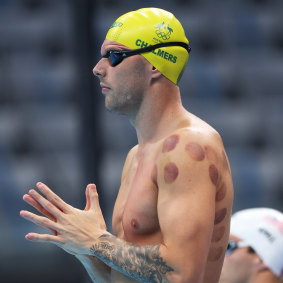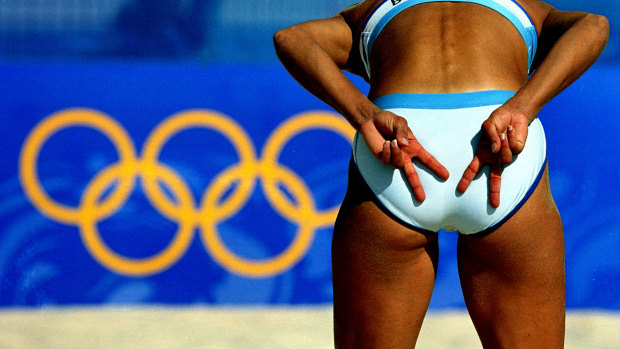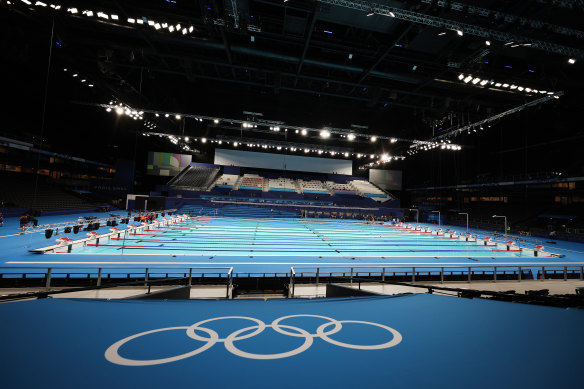By Iain Payten
A fortnight of devouring Olympics content will expose you to an array of unusual sights, weird commentary terms and just plain strange traditions and habits.
And they’re the sort questions someone will ask on the couch, at the pub or at a barbecue: “What’s with people having a spa at the diving?“
Well, we’ve done the legwork to get you the answers.
What are those red circles on some swimmers’ backs?

Kyle Chalmers before the men’s 4x100m freestyle relay. Credit: Getty
They’re bruises, essentially. Olympic swimmers are often big fans of “cupping” therapy, a Chinese practice of sucking away the skin from the muscles to stimulate blood flow.
It is supposed to help with faster recovery and ease sore muscles. Michael Phelps was a big fan, and Kyle Chalmers is, too.
First the skin is first wiped with alcohol, then a match is lit inside a small cup to build heat. The cup is then put on the skin and the heat and pressure pulls the skin up. Capillaries near the surface break which leaves the red marks.
Why are some races called a blue riband event? Or is it blue ribbon?
They mean the same thing – riband is the old-fashioned version of ribbon. Blue riband/ribbon events are typically seen as the best, or highest-quality, races or competitions – so think the 100m sprint, the 100m freestyle in swimming or the eights rowing race. The prestige attached to a blue-ribbon traces back to the late 1500s, when a group of elite French knights (Les Chevaliers du Saint Esprit) would hang a signature cross off a blue ribbon (le cordon bleu). If that sounds like something you’ve heard on a cookery show, that’s because French chefs adopted the same convention by using the blue ribbon on their aprons.
Away from the kitchen or the world of chivalry, one of the first places where the term was used in the sense of an elite sporting contest was when the Blue Riband award was offered to the commercial liner that made the fastest trans-Atlantic crossing at the start of the 20th century.
Why do divers jump in the spa after every dive?
Watch any diving and you’ll see the athletes hop out of the pool and get straight into a shower or a spa or both. It is done to keep a diver’s muscles warm and loose after a few minutes of pre-dive routine ends with the athlete plunging into a chilly pool.
Done repeatedly over a few hours, that can make muscles get cold and tight. Spas and pools are the diving equivalent of footballers wearing a big warm jacket on the sideline.
What’s with all the sniffing and white powder at the weightlifting?
It may sound like a Saturday night out in Sydney but the use of ammonium carbonate and magnesium carbonate is not only legal for weightlifters to enhance performance at the Olympics, it is extremely common. They are otherwise known as smelling salts and weightlifting chalk.
Lifters take a whiff from a small bottle of an ammonia-based solution, inhaling the powerful gas to trigger a reflex in the nasal membrane and lungs, which causes the body to take in more oxygen. That increases alertness and energy and acts like a shot of adrenalin for a few minutes.
The white chalk is used to ensure the hands are perfectly dry and don’t slip at all on the metal bar.
What is a repechage?
It’s effectively a second-chance saloon for athletes who don’t automatically qualify for the final in the heats. A collection of runners-up will compete in a repechage and the winner of that race will earn a spot in the final. Seen in rowing and cycling.

A beach volleyballer signalling to her partner where she is going to block.Credit: ALLSPORT AUSTRALI
What are hand signals at the beach volleyball?
You know the ones, don’t pretend you don’t. Most photos from the beach volleyball are of the hand signals being shown behind the back.
Why are the Matildas at the Olympics but not the Socceroos?
Since 1992, the men’s football tournament has been an under-23s competition and the basic reason is that neither FIFA nor the IOC wants the Olympics to be a competitor to the ginormous FIFA World Cup. There are three slots for over-23s on each roster, but for various reasons, very few megastars take up the chance to play at the Olympics. The Euros and COPA tournaments are staged near the Olympics, and clubs don’t like their stars doing both. The Olympics are not in a FIFA release window, meaning clubs don’t have to let stars go.
The women’s Olympic tournament was added in 1996 and did not have any age restriction applied. Unlike the men, FIFA even makes it illegal for clubs to block Olympic call-ups. The difference is due to women’s football, historically, having a smaller profile, but after the booming growth of women’s World Cups recently, you wonder how long that will last?
What is a B-girl and why is she top rocking?
Break-dancing, or just “breaking”, is an Olympic sport in the Paris Games. It was the hosts’ choice, and part of the IOC plan to attract younger audiences. Much has been written about the why, but you’ll need some basics on the how.
Breakers, aka B-Boys and B-Girls, compete in a one-on-one battle to unfamiliar music spun by a DJ. It’s scored on a combination of creativity, skill and physicality. The moves are “top rock” (steps done on your feet), “down rock” (moves on the floor), “power moves” (like head spins and windmills) and “freezes”, which are self-explanatory.
Why do two boxers win bronze medals?
There is obviously a gold medal fight and the loser wins silver. But there are no bronze medal bouts in Olympic boxing – they just give both losing semi-finalists a bronze each. The concept was introduced in 1950, initially as a scheduling thing, but is now more about the welfare of two defeated fighters. So win a quarter-final and you’re an Olympic medallist.
What’s the difference between a canoe and a kayak?
This is the way to remember which is which: in a kayak you use a two-bladed paddle and in a canoe, it’s one blade (and with the paddler up on a knee). Remember to revise, there will be a test.
Why are the sprinklers always on at the hockey?
Go to a hockey game and just before they run on, it appears like a groundskeeper is going to get fired because the sprinklers are blasting all across the pitch. It’s all planned. On synthethic grass, a layer of water helps the ball travel smoothly and consistently across the ground.
What temperature is the Olympic pool?
World Aquatics regulations state Olympic 50m pools must be kept at a temperature of between 25 and 28 degrees celsius, which is probably cooler than your local council pool, which can be closer to 30 degrees, or above.

The competition pool in Paris La Defense Arena.Credit: Getty Images
Most Olympic Games pools are set at the “Goldilocks” temperature of 27 or 28 degrees because if it’s too cold then muscles can tighten up and if it’s too warm, athletes can suffer as they sweat and dehydrate over long distances.
What on earth is that mascot?
Syd, Millie, Ollie and Fatso were pretty easy to understand as the Sydney 2000 mascots of Sydney 2000. Wenlock the steel girder with a camera face was a bit stranger in London 2012, and you’ll need an explanation for the Paris Olympics mascot as well.
Those little red things are Olympic Phyrges, which are based on an item of clothing that has been a part of French history for centuries. Widely popularised by French revolutionaries, the Phrygian cap is “a symbol of revolution, the French Republic and freedom”.
What’s with the fighting at the surfing?
One of the interesting changes to the Olympic surfing is athletes will be dropped from a boat and have to race to the waves for priority, instead of a coin toss. Given the surfing is at Teahupo’o, the fearsome break at Tahiti, that could see the danger level increased with a first wave possibly taken in haste.
The dangers of Olympic surfing at a break that has claimed lives in the past has stoked up attention, and though the competition safety levels will be huge, we’ll just leave this fact here – there have been two deaths of Olympians in the middle of competition: Portugese runner Francisco Lázaro (1912) and Denmark cyclist Knud Enemark Jensen (1960), who both died of heat stroke.
Am I watching ping-pong or table tennis?
The latter. While we may swap the two terms for a game involving a couple of bats and the little white ball, there is a difference. Table tennis is an organised and highly-regulated sport, and that’s what you’re watching at the Olympics.
Ping-pong is more used to refer to the recreational activity in your garage. After table tennis was invented in the late 1800s, the sound of a celluloid ball being hit back and forth led to it being called ping-pong and even “whiff-whaff”. An American toy company patented the name “ping-pong” and via the popularity of the kits they sold, the name became synonymous with the sport.
For Olympics news, results and expert analysis sent daily throughout the Games, sign up for our Sport newsletter.